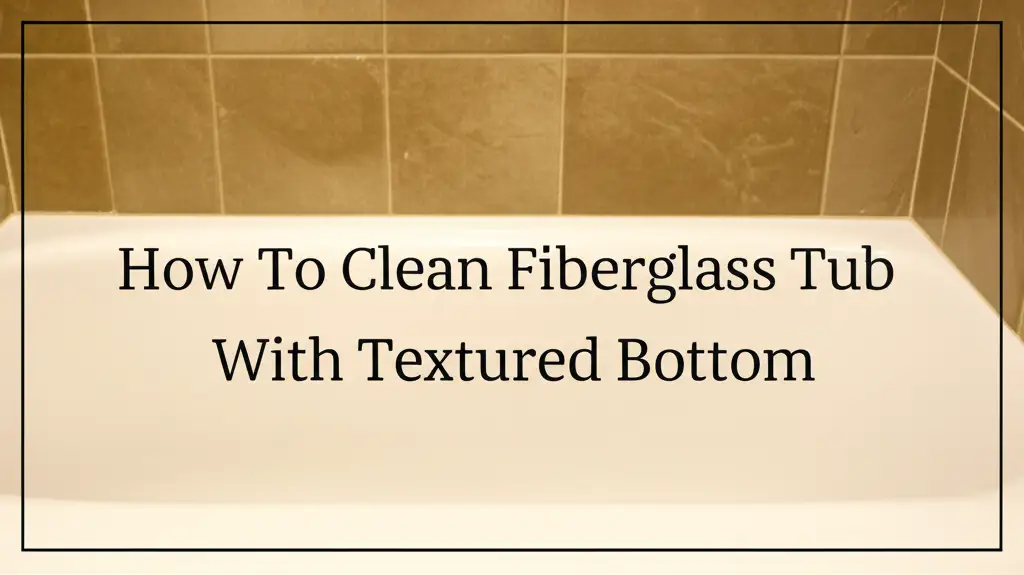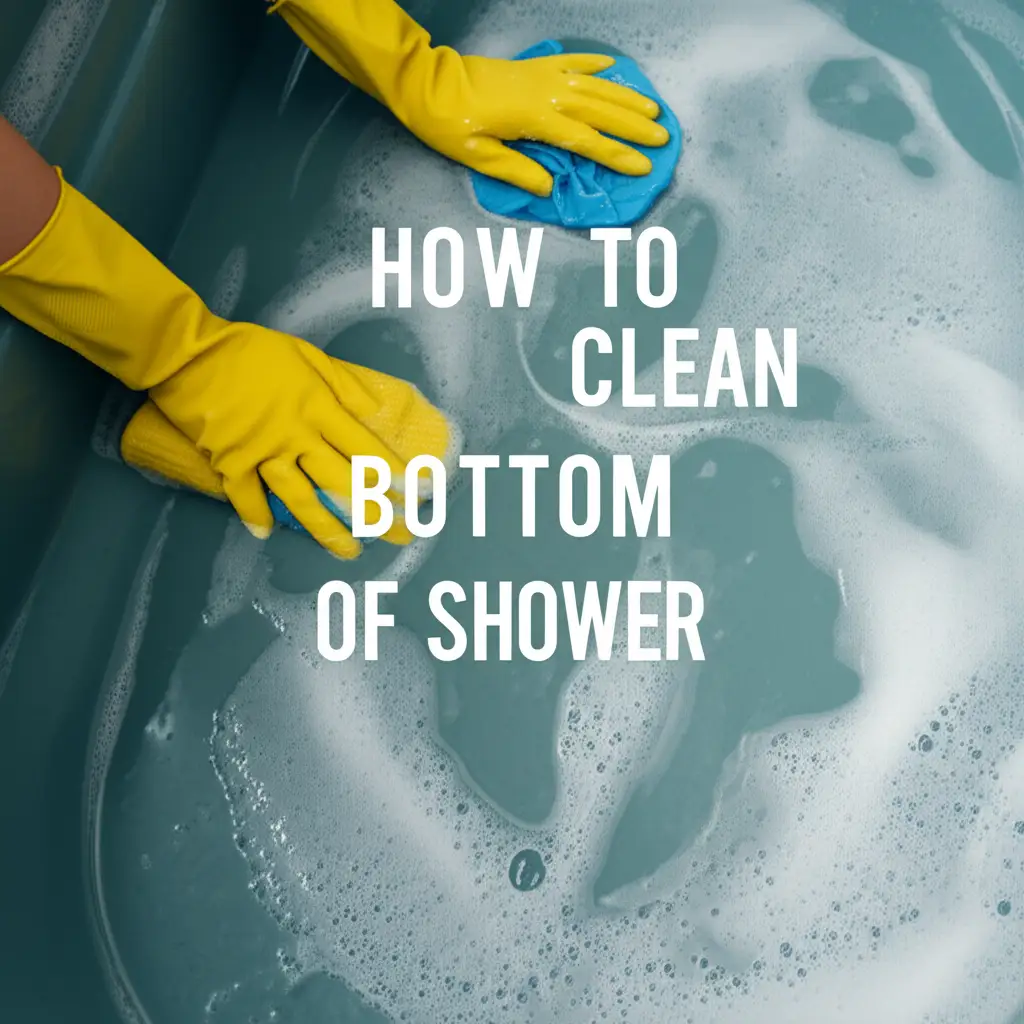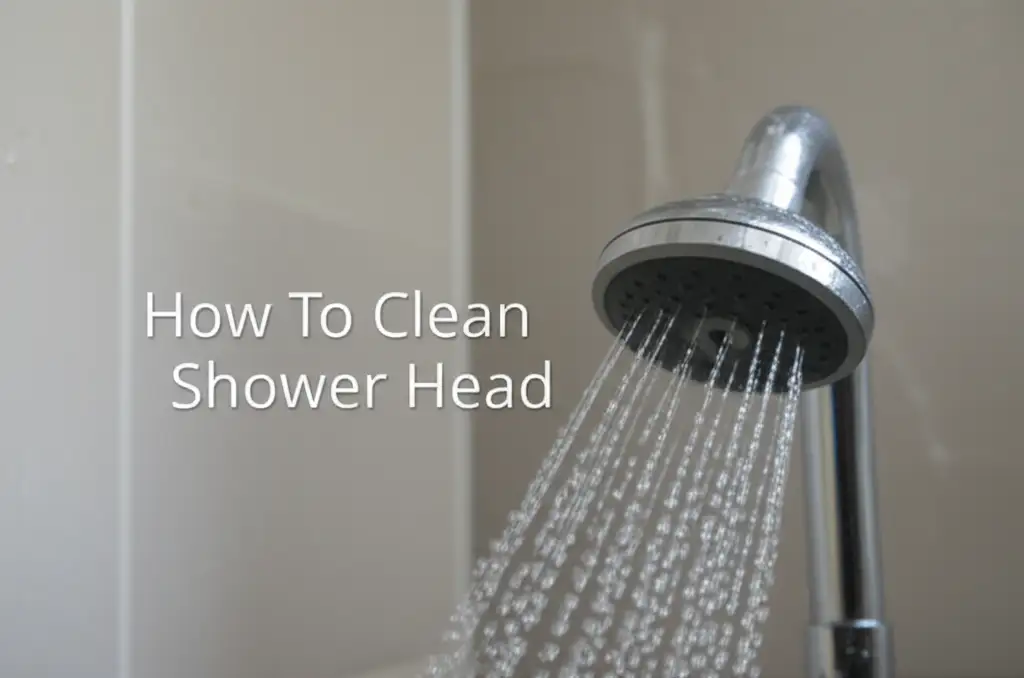· Bathroom Cleaning · 12 min read
How To Clean Fiberglass Tub With Textured Bottom

Clean Fiberglass Tub with Textured Bottom: A Simple Guide
Has your once bright, fiberglass tub started looking dull? Does its textured bottom feel less safe and more grimy? Cleaning a fiberglass tub with a textured bottom can seem tricky. The tiny grooves catch dirt and soap scum. They can become discolored over time.
But do not worry. This guide offers simple, effective ways to restore your tub’s shine. You will learn how to clean a fiberglass tub with a textured bottom using common household items. We will cover gentle daily cleaning and methods for stubborn stains. Get ready to make your tub look fresh again.
Takeaway
- Use gentle, non-abrasive cleaners and soft brushes to avoid damaging fiberglass.
- Baking soda and vinegar offer effective, natural cleaning power.
- Regular cleaning prevents the buildup of soap scum and mildew.
- Always test cleaning products in a small, hidden area first.
To clean a fiberglass tub with a textured bottom, use a soft-bristle brush or nylon scrub pad with a mild cleaner like baking soda paste or a diluted white vinegar solution. Scrub the textured surface gently but firmly in small sections, then rinse thoroughly with warm water. Avoid harsh chemicals or abrasive tools to protect the fiberglass.
Understanding Fiberglass Tubs and Their Textured Surfaces
Fiberglass tubs are popular because they are light and affordable. They feel warm to the touch. These tubs often have a textured bottom. This texture adds grip. It helps prevent slips and falls when the tub is wet.
The textured surface creates many small grooves. These grooves collect dirt, soap scum, body oils, and mineral deposits. Over time, these trapped particles lead to discoloration. They also make the tub feel rough or sticky. Standard smooth tub cleaning methods often do not work well on these textured parts. You need special care to clean fiberglass effectively. This keeps the non-slip feature working and the tub looking good.
Fiberglass material is durable but can scratch. It reacts poorly to strong chemicals. Using abrasive cleaners or scrubbers damages the surface. This damage makes the tub even harder to clean in the future. It can also strip away the smooth, protective gel coat. Knowing your tub’s material helps you choose the right cleaning approach.
Gathering Your Essential Cleaning Supplies
Before you begin to clean your fiberglass tub with a textured bottom, gather your tools. Having everything ready makes the job easier. It also ensures you use safe items for fiberglass. You want to avoid anything that scratches or harms the surface.
Here is a list of recommended supplies:
- Soft-bristle brush or nylon scrub pad: These tools clean effectively without scratching. Avoid wire brushes or rough sponges.
- Baking soda: A gentle abrasive and deodorizer. It helps lift dirt.
- White vinegar: A natural acid that breaks down soap scum and mildew. It also helps with mineral deposits. You can learn more about how to clean with vinegar and baking soda. how to clean with vinegar and baking soda
- Mild dish soap: Good for general grime and grease. Choose one without harsh dyes or perfumes.
- Spray bottle: Useful for applying vinegar or other liquid solutions.
- Clean cloths or sponges: For wiping down surfaces and rinsing.
- Rubber gloves: To protect your hands from cleaners.
- Optional: Oxygen bleach or a specialty fiberglass tub cleaner for tougher stains. Always check product labels for safety on fiberglass.
Having these items ready helps you start and finish cleaning without interruption. It also ensures you protect your fiberglass tub during the process.
The Gentle Daily Cleaning Method
Regular cleaning prevents dirt from building up in your fiberglass tub’s textured bottom. This simple daily method keeps your tub fresh. It stops soap scum and grime from becoming stubborn problems. This approach is quick and easy to add to your routine.
First, after each use, quickly rinse the tub with warm water. This washes away loose dirt and soap residue. Next, use a small amount of mild dish soap on a soft cloth or sponge. Wipe down the entire tub, including the textured bottom. You do not need much effort for this step.
After wiping, rinse the tub thoroughly with water. Make sure all soap is gone. You do not want soap residue left behind. This residue can lead to new soap scum. Finally, use a clean, dry cloth to wipe the tub dry. Drying prevents water spots and mildew growth. This small effort after each use makes a big difference. It helps maintain the appearance and safety of your fiberglass tub’s textured surface. This method also protects the fiberglass from damage.
Deep Cleaning for Stubborn Grime and Mildew
Sometimes, daily cleaning is not enough. The textured bottom of a fiberglass tub can trap persistent grime and mildew. When this happens, a deeper clean is necessary. You can use common household items for this task. These items are effective and safe for your fiberglass surface.
First, start by rinsing the tub with warm water. This helps loosen some surface dirt. Next, sprinkle a generous amount of baking soda over the entire textured bottom. For extra power, mix the baking soda with a little water to form a thick paste. Spread this paste evenly over the grimy areas. Baking soda works as a gentle abrasive. It helps lift dirt and deodorizes. It is a good choice for removing stains from many surfaces. You can even use baking soda to clean stains off a mattress. clean stains off mattress with baking soda
Let the baking soda paste sit for about 15-30 minutes. This gives it time to work on the grime. After it sits, use a soft-bristle brush or a nylon scrub pad. Gently scrub the textured surface in small, circular motions. Focus on areas with visible grime or mildew. You will see the dirt lifting away.
For mildew and tougher soap scum, follow the baking soda with white vinegar. Pour or spray white vinegar directly over the baking soda. The mixture will fizz. This reaction helps break down more stubborn deposits. Let this mixture sit for another 10-15 minutes. Then, scrub again with your soft brush. The vinegar acts as a disinfectant and dissolves mineral buildup. It is an ideal companion to baking soda for many cleaning tasks. Many people use a combination of vinegar and baking soda to clean things like washing machines. how to clean washing machine with baking soda and vinegar
After scrubbing, rinse the tub thoroughly with warm water. Make sure all the cleaning solution and lifted grime wash away. You may need to rinse several times. Finally, dry the tub completely with a clean cloth. This prevents new water spots and mildew. This deep cleaning method brings your fiberglass tub’s textured bottom back to life.
Tackling Tough Stains on Your Textured Tub
Even with regular cleaning, some stains on a textured fiberglass tub can be stubborn. Rust stains, hair dye, or persistent mineral deposits often need specific treatment. Fiberglass is delicate, so always use caution. Avoid harsh chemicals that can damage the surface.
For rust stains or mineral deposits, try a lemon juice and borax paste. Mix enough borax with lemon juice to form a thick paste. Apply this paste directly onto the stain. Let it sit for 30 minutes to an hour. The acid in lemon juice helps break down the minerals. Borax adds mild abrasive power. After waiting, gently scrub the stain with a soft-bristle brush. Rinse thoroughly with water. Repeat if needed.
For hair dye or other organic stains, a mixture of hydrogen peroxide and baking soda can work. Create a paste with these two ingredients. Apply the paste to the stain. Cover it with plastic wrap to keep it moist. Let it sit for several hours or even overnight. Hydrogen peroxide is a mild bleaching agent. It helps lift color stains. After the waiting period, scrub gently and rinse completely. Always test this method in an inconspicuous area first.
If stains persist, consider an oxygen bleach product designed for bathrooms. Read the product label carefully. Ensure it is safe for fiberglass. Mix according to directions and apply to the stained area. Let it sit for the recommended time. Then scrub and rinse. Always ventilate the bathroom well when using such products. Remember, patience is key with tough stains. Sometimes, multiple applications of a gentle cleaner work better than one harsh treatment.
Restoring Shine and Preventing Future Buildup
Once your fiberglass tub with a textured bottom is clean, you want to keep it that way. Restoring its shine and preventing future buildup makes cleaning easier. It also extends the life of your tub. Simple steps can maintain its fresh look.
First, consider applying a fiberglass protectant or car wax. After the tub is completely dry, apply a thin layer of protectant. Follow the product instructions for application and buffing. This creates a protective barrier. It makes the surface smoother and less likely to trap dirt. Water and soap scum will bead up and rinse away more easily. This helps maintain the clean look. It also makes future cleaning simpler.
Next, focus on preventing mildew and soap scum. Good ventilation is crucial. Always run the bathroom fan during and after showers. Open windows if possible. This helps dry out the tub quickly. Moisture is a friend to mildew. Drying the tub after each use is also a simple yet effective step. Use a squeegee or a soft towel to wipe down the tub walls and bottom. This removes excess water before it can evaporate and leave mineral deposits or soap film.
Lastly, maintain a regular cleaning schedule. Even a quick rinse and wipe-down after each use helps a lot. A weekly wipe with a mild cleaner prevents buildup. This prevents grime from settling deep into the texture. It keeps your tub looking clean and bright. These habits protect your tub’s surface. They also ensure the textured bottom stays effective for slip prevention.
Safety Precautions and Best Practices
Cleaning your fiberglass tub with a textured bottom requires attention to safety. You work with water, cleaners, and slippery surfaces. Following best practices protects you and your tub. Always prioritize safety first.
Wear rubber gloves to protect your hands from cleaning solutions. Even mild cleaners can irritate skin. Good ventilation is also very important. Open windows or turn on the bathroom fan. This helps clear any fumes from cleaners. Fresh air makes the cleaning process safer and more comfortable.
Always test any new cleaning product in a small, hidden area of your tub. This step ensures the product does not stain or damage the fiberglass. Apply a small amount, wait a few minutes, then rinse. Check for discoloration or dullness. If the area looks good, proceed with cleaning the rest of the tub. This simple test prevents big problems.
Avoid using abrasive cleaners or tools. Steel wool, harsh scouring powders, and stiff brushes can scratch fiberglass. These scratches dull the surface. They also create more places for dirt to hide. Stick to soft brushes, nylon scrub pads, or cloths. Harsh chemical cleaners like bleach, ammonia, or strong acid-based removers can also damage fiberglass. They may break down the gel coat. This leads to permanent dullness or yellowing. If you need a strong cleaner for drains, be careful. Harsh chemicals can also damage other bathroom components like hair in drains. how to clean hair out of bathroom sink drain
Rinse the tub thoroughly after cleaning. Leftover cleaning solution can dry and leave residue. This residue can attract more dirt or even damage the surface over time. Ensure all cleaning agents are washed away completely. Finally, store cleaning products safely. Keep them out of reach of children and pets. Proper storage prevents accidents. By following these safety tips, you can clean your tub effectively and keep it looking great for years.
FAQ Section
Can I use bleach on a fiberglass tub with a textured bottom?
Using chlorine bleach on fiberglass tubs is generally not recommended. It can yellow the fiberglass and degrade the gel coat over time. For mildew, try hydrogen peroxide or oxygen bleach labeled safe for fiberglass. These options are less harsh and still effective.
How often should I clean my textured fiberglass tub?
For optimal results, aim for a quick rinse and wipe after each use. A gentle weekly cleaning with baking soda or vinegar helps prevent buildup. Deep cleaning may be needed monthly or as grime appears. Regular care keeps stubborn stains away.
What causes the textured bottom to get so dirty?
The textured bottom has tiny grooves designed for slip resistance. These grooves trap soap scum, body oils, dirt, and mineral deposits. Over time, these trapped particles accumulate and cause discoloration. Regular light cleaning helps prevent this buildup.
Can I use a magic eraser on my fiberglass tub?
A “magic eraser” is made of melamine foam, which is a very fine abrasive. While it can remove some stains, it can also scratch or dull the gel coat of a fiberglass tub. Use it with extreme caution and only on small, hidden areas as a test.
How do I prevent mold and mildew on the textured bottom?
Preventing mold and mildew involves reducing moisture. Always run the bathroom fan during and after showers. Wipe the tub dry after each use. Use a daily shower spray that inhibits mildew growth. Regular cleaning also stops mold from taking hold.
What if my tub has scratches?
Minor scratches on fiberglass can sometimes be buffed out using a fiberglass repair kit or a fine polishing compound made for fiberglass. For deeper scratches, professional repair might be necessary. Always follow product instructions carefully when attempting repairs.
Conclusion
Cleaning a fiberglass tub with a textured bottom does not have to be a difficult task. By understanding the material and its unique surface, you can choose the right tools and cleaning solutions. Gentle, consistent care is key to keeping your tub looking its best. We covered everything from daily maintenance to tackling stubborn stains.
Remember to use soft brushes and non-abrasive cleaners like baking soda and vinegar. Always prioritize safety by wearing gloves and ensuring good ventilation. Regular cleaning and drying after each use will prevent future buildup. This keeps your non-slip textured bottom clean and functional. Following these steps will help you enjoy a sparkling clean and safe fiberglass tub for years to come.
- fiberglass tub cleaning
- textured tub cleaner
- remove tub stains
- non-slip tub care
- bathroom maintenance




